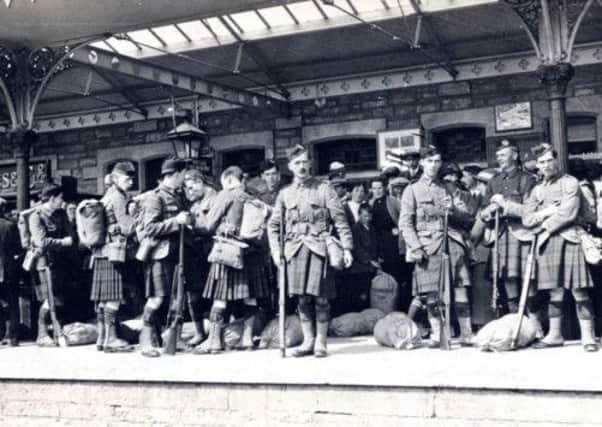The Kingussie shinty heroes that went to war


On the Kingussie war memorial there are 60 names from the war, and the calendar is in memory of them all as well as the men who survived. There are a further two of the Kingussie shinty squad listed on the war memorial at nearby Laggan.
The calendar has twin purposes:: to celebrate the 1914 Camanachd Cup-winning team and to remember the Kingussie men who died during an altogether more grievous conflict.
Advertisement
Hide AdAdvertisement
Hide AdResearching the calendar has centred around the Kingussie shinty players and it has shown that the young men, who were employed in similar professions to today’s players, were prepared to volunteer to serve their country and in some cases to pay the ultimate sacrifice.
On 4 April, 1914 a special train left Aviemore at 6am carrying 200 passengers to the 1914 Camanachd Cup final at Possil Park, Glasgow. Kingussie produced one of the best performances in the club’s history and beat Kyles 6-1. The team arrived back in Kingussie at too late an hour for an official celebration, so on the following Wednesday evening a dinner was hosted in the Star Hotel for the players.
On Tuesday, 4 August, 1914 the Headquarters of Scottish Command in Edinburgh received a telegram from the British Government which simply read “Mobilise”. Britain had declared war on Germany. At noon on 5 August, 1914, the Kingussie contingent of the Cameron Highlanders left Kingussie Railway Station on the north-bound train for Inverness. Some of them never returned.
Kingussie’s war record compares with any other burgh in the UK. At least 50 per cent of the male population signed up for the various branches of the Army and Navy, some of the men travelling thousands of miles from the Colonies to make their contribution. Practically every Kingussie Territorial volunteered for the front when asked to do so at the training centre at Bedford.
It was at Neuve Chapelle in March 1915 that the Kingussie men got their first introduction to the grim realities of war. Eleven months after celebrating a Camanachd Cup victory, the young men from Kingussie were in front-line action in the fields of Northern France. More Kingussie men died at the Battle of Festubert in May 1915 than at any other World War I battle.
The battle lasted several days and was the first of the war to be fought at night. The Cameron Highlanders were at the southern end of a front line which was nearly three miles long. At Festubert, the Kingussie men were in front-line action on 17 and 18 May.
During the fighting, the Cameron Highlanders came under intense fire when attacking a German trench. The Kingussie captain, John Campbell, who was second in command of C-Company Cameron Highlanders, died while trying to cover the retreat of his men. It was a heroic death.
He stood in a southern ditch and fired for all he was worth at the advancing Germans until he fell. He was the son of Lieutenant-Colonel Ewan Campbell.
Advertisement
Hide AdAdvertisement
Hide AdA young Kingussie Territorial, who survived the battle of Festubert, sent a letter home describing the fighting. An extract from the letter reads: “We got the order to march to the front trenches at 5pm on 17th May, 1915. We had to wait 20 minutes while our artillery were shelling the German position. Then we got the order to fix bayonets and charge. As we went over the top the German gunners opened fire on us, but we kept on. Our boys were getting bowled over but we reached the German front-line trench and found they had evacuated it. In the morning at the roll call there were 30 Kingussie boys amongst the killed and wounded. I don’t know how we weren’t all killed.”
The Badenoch Record on 29 May 1915 published an account of Festubert from another Kingussie Territorial. “We got the order to charge on 17 May but immediately we got over the parapet the Germans opened fire on us. The German trench was about 800 yards away and we were under fire the whole way. We took the German front-line trench, then our troubles began. In the morning the Germans, who had moved back to another trench, started bombing us. We had to retire and it was then that we sustained most of our casualties.
“We hit on an idea of digging a small trench to the nearest ditch, and we got away this way with the advancing Germans only 30 yards away. We slipped through the enemy’s fingers and then took two hours to get back to our own trench, up to our necks in water the whole way.”
One month after the battle of Festubert, in June 1915, the Cameron Highlanders were ordered to take part in the second battle of Givenchy, which took place about a mile south of Festubert. The Allied troops had learned many lessons by then, in particular the difficulties of facing barbed wire and machine-gun nests. On 15 June, the Cameron Highlanders went over the top as part of a front-line attack. The German line was formidable and 20 Cameron Highlanders were killed with another 38 injured.
The tale of the Kingussie men echoes the story of other Scottish sporting teams who displayed courage and valour by leaving their lives behind to fight in the War, such as McCrae’s Batallion, which included the Heart of Midlothian football team. The release of the calendar is the perfect way to ensure that their story continues to be remembered from generation to generation.